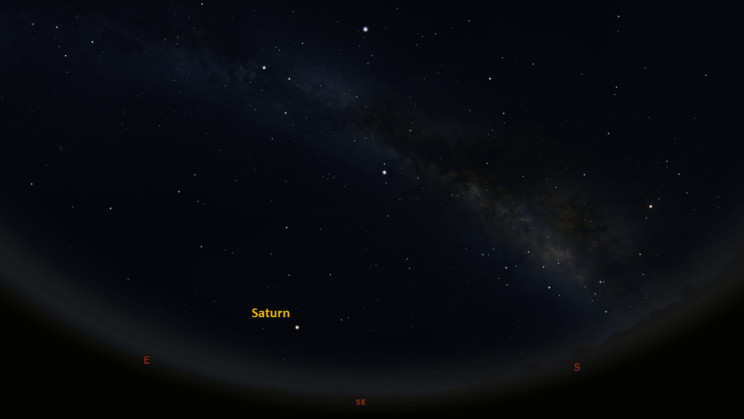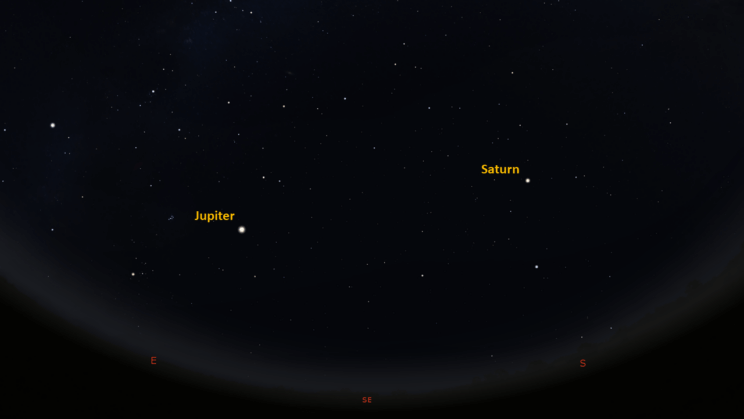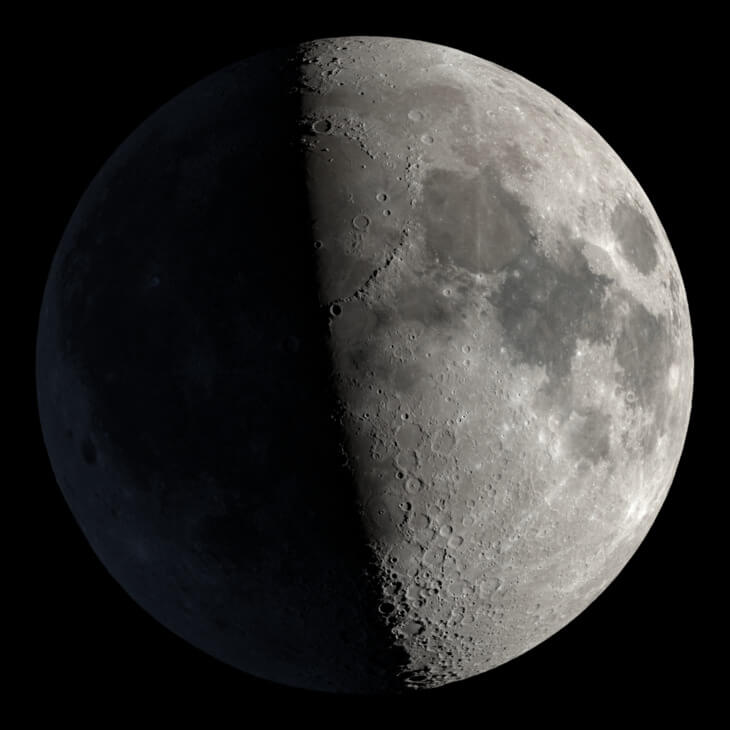This is the Saint Louis Science Center’s NIGHT SKY UPDATE for the week of Saturday, August 19, 2023.
Information updated weekly or as needed.
Times given as local St. Louis time which is Central Daylight Time (CDT). For definitions of terminology used in the night sky update, click the highlighted text. If relying on times posted in Universal Time (UT), St. louis is -5 hours when CDT.
Public Telescope Viewings
As part of the Saint Louis Science Center’s First Fridays, weather permitting, the St. Louis Astronomical Society and the Science Center will set up a number of telescopes outdoors and be on-hand to answer your questions. Telescope viewing begins once it is dark. Regardless of the weather on September 1 , join us indoors in our planetarium theater for “The Sky Tonight”. Showtime is at 7 p.m. There is no First Friday event in July.
Observing Highlight of the Week
On August 24, 2023, the Moon will exhibit a waxing gibbous phase with roughly 55% disk illumination. Image credit: NASA’s Scientific Visualization Studio, Ernie Wright, Noah Petro, David Ladd
On August 24, 2023, the Moon will occult the bright star Antares. Occultations are a type of syzygy in which something passes between you and a distant object blocking it from view. Occultations typically involve the Moon, planets, dwarf planets and asteroids.
Observing occultations are important because they often reveal information about one of the objects involved. Famously, Uranus’s rings were discovered when the planet occulted a distant star. We can learn about the size and shape of the objects involved. We can also learn about planetary atmospheres as the planet passes in front of a star.
The occultation of Antares by the Moon will be visible from most of North America. For viewers in St. Louis, Antares will disappear behind the Moon at 9:28 p.m. CDT and it will reappear at 10:33 p.m. CDT. On this night the Moon will exhibit a waxing gibbous phase with roughly 55.48% disk illumination. To see the end of the occultation, you will need a clear view of the southwest as the Moon and Antares will be just under 10° above the horizon.
Next month something similar will happen with the Moon and Mars. The occultation of Mars occurs on September 16, 2023. It is technically visible from St. Louis, but it is not something I would recommend to everyone. The danger in this occultation is it occurs during the daytime. Those not experienced in finding planets during the day should not attempt to view this occultation. The Moon and Mars will both appear near the Sun that day, so it is dangerous to observe. Additionally, the Moon will be just hours into the lunar cycle, so it will be difficult to resolve. If weather permits, I will attempt to record the event. If I am successful, I will post the results in the night sky update.
The Sun and Moon

The Moon as seen from the International Space Station, on July 31, 2011.
Credit: NASA
Sun
Sunrise is at 6:18 a.m. on Saturday, August 19 and sunset is at 7:50 p.m. providing us with roughly 13.5 hours of daylight. Even after sunset, light from the Sun will dimly illuminate our sky for about 1 hour and 40 minutes. This period is called twilight, which ends around 9:27 p.m. this week. For those with a sundial, local noon occurs around 1:04 p.m. this week.
| Day | Sunrise | Sunset | ||||||||||
|---|---|---|---|---|---|---|---|---|---|---|---|---|
| 19-Aug | 6:18 a.m. | 7:50 p.m. | ||||||||||
| 20-Aug | 6:19 a.m. | 7:48 p.m. | ||||||||||
| 21-Aug | 6:20 a.m. | 7:47 p.m. | ||||||||||
| 22-Aug | 6:21 a.m. | 7:46 p.m. | ||||||||||
| 23-Aug | 6:22 a.m. | 7:44 p.m. | ||||||||||
| 24-Aug | 6:23 a.m. | 7:43 p.m. | ||||||||||
| 25-Aug | 6:24 a.m. | 7:41 p.m. | ||||||||||
| 26-Aug | 6:24 a.m. | 7:40 p.m. | ||||||||||
| 27-Aug | 6:25 a.m. | 7:38 p.m. |
Moon
Moonrise for Saturday, August 19 was at 2:18 a.m. and moonset occurs at 6:11 p.m. On Saturday, August 19, the Moon will exhibit a waxing crescent phase with 10% disk illumination. First quarter moon occurs on August 24, 2023, at 4:57 a.m.
International Space Station (ISS) Observing

There are a few visible passes of ISS from St. Louis for the week of August 19. They occur during morning hours. Use the table below for information about these passes.
Catch ISS from St. Louis starting Saturday, August 19
| Date | Starts | Max. altitude | Ends | |||||||
|---|---|---|---|---|---|---|---|---|---|---|
| Time | Alt. | Az. | Time | Alt. | Az. | Time | Alt. | Az. | ||
| 19 | -1.1 | 5:32:05 | 10 | SSE | 5:34:10 | 16 | SE | 5:36:15 | 10 | E |
| 21 | -3 | 5:31:48 | 10 | SSW | 5:35:02 | 48 | SE | 5:38:18 | 10 | ENE |
Magnitude (Mag): The Measure of brightness for a celestial object. The lower the value is, the brighter the object will be.
Altitude (Alt): The angle of a celestial object measured upwards from the observer’s horizon.
Azimuth (Az): The direction of a celestial object, measured clockwise from an observer’s location with north being 0°, east being 90°, south being 180° and west being 270°.
Detailed information regarding all unmanned exploration of our universe, missions past, present, and planned, can be found at Jet Propulsion Laboratories:
The Visible Planets

Looking southeast at 9:30 p.m. on August 19, 2023. Credit: Stellarium, EG

Looking southeast at 2:00 a.m. on August 20, 2023. Credit: Stellarium, EG
This week, three naked eye planets will be visible. Mars is still visible in the west about 30 minutes after sunset. It will be low so twilight will make spotting Mars challenging. Saturn and Jupiter will be easy to find but you will have to go out in the late evening and morning hours. Saturn will be in the southeast around 9:30 p.m., while Jupiter will be in the east by 2:00 a.m.
Mars
Mars now rises before sunset, becoming visible once it is dark. Look for it in the west about 30 minutes after sunset. Mars sets at 9:00 p.m.
Jupiter
Jupiter rises at 11:10 p.m. About one hour after Jupiter rises, it should be easy to spot. Jupiter will rise about 20 minutes earlier each week.
Saturn
Saturn rises at 8:13 p.m. Start looking for Saturn about 30 minutes after it rises. If you have lots of trees or buildings, you may have to wait an hour or so after it rises before it will be visible. Saturn reaches opposition on August 27, 2023.
James S. McDonnell Planetarium
Night Sky Update: August 19-27, 2023







